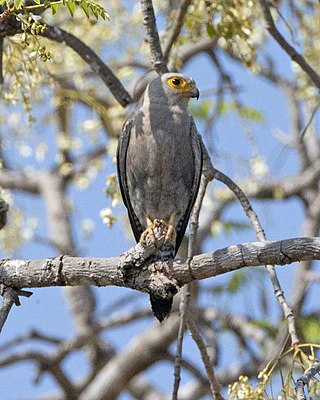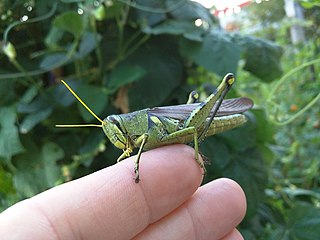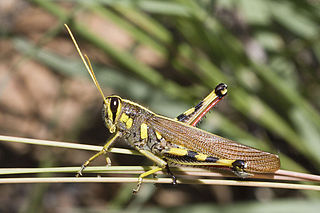
Locusts are various species of short-horned grasshoppers in the family Acrididae that have a swarming phase. These insects are usually solitary, but under certain circumstances they become more abundant and change their behaviour and habits, becoming gregarious. No taxonomic distinction is made between locust and grasshopper species; the basis for the definition is whether a species forms swarms under intermittently suitable conditions; this has evolved independently in multiple lineages, comprising at least 18 genera in 5 different acridid subfamilies.

Say's phoebe is a passerine bird in the tyrant flycatcher family. A common bird across western North America, it prefers dry, desolate areas. This bird was named for Thomas Say, the American naturalist.

Grasshoppers are a group of insects belonging to the suborder Caelifera. They are among what is possibly the most ancient living group of chewing herbivorous insects, dating back to the early Triassic around 250 million years ago.

The desert locust is a species of locust, a periodically swarming, short-horned grasshopper in the family Acrididae. They are found primarily in the deserts and dry areas of northern and eastern Africa, Arabia, and southwest Asia. During population surge years, they may extend north into parts of western Spain and southern Italy, south into Eastern Africa, and east in northern India. The desert locust shows periodic changes in its body form and can change in response to environmental conditions, over several generations, from a solitary, shorter-winged, highly fecund, non-migratory form to a gregarious, long-winged, and migratory phase in which they may travel long distances into new areas. In some years, they may thus form locust plagues, invading new areas, where they may consume all vegetation including crops, and at other times, they may live unnoticed in small numbers.

The vermilion flycatcher is a small passerine bird in the tyrant flycatcher family found throughout South America and southern North America. It is a striking exception among the generally drab Tyrannidae due to its vermilion-red coloration. The males have bright red crowns, chests, and underparts, with brownish wings and tails. Females lack the vivid red coloration and can be hard to identify—they may be confused for the Say's phoebe. The vermilion flycatcher's song is a pit pit pit pidddrrrreeedrr, which is variable and important in establishing a territory. Riparian habitats and semi-open environments are preferred. As aerial insectivores, they catch their prey while flying. Their several months-long molt begins in summer.

Dickinson's kestrel is a bird of prey of southern and eastern Africa belonging to the falcon family Falconidae. It is named after John Dickinson, an English physician and missionary who collected the type specimen. It is also known as the white-rumped kestrel. Its closest relatives are the grey kestrel and banded kestrel and the three are sometimes placed in the subgenus Dissodectes.

Schistocerca nitens is a species of grasshopper known by several names, including vagrant grasshopper and gray bird grasshopper. It is a close relative of the desert locust, which is in the same genus. This grasshopper is native to southern North America including Mexico and the south-western United States from California to Texas. Vagrants are occasionally found in Colorado and Nebraska, where the climate is too cold for them to reproduce, otherwise. It is also present in parts of Central and South America. It lives in many habitats including desert, woodland, and lower elevation mountainous areas. It is a large grasshopper, reaching lengths of 4 to 7 centimeters. It is mostly brown and gray spotted or patched in cryptic coloration. This species is known as a pest on ornamental plants and many types of crop plants.

Schistocerca is a genus of grasshoppers, commonly called bird grasshoppers, many of which swarm as locusts. The best known species is probably the desert locust and trans-Atlantic flight may explain the biogeography of some locust species.
The largest animal known ever to have lived is confirmed to be the blue whale. The maximum recorded weight was 190 tonnes for a specimen measuring 27.6 metres (91 ft), whereas longer ones, up to 33.6 metres (110 ft), have been recorded but not weighed. It is estimated however that this individual could have a mass of 250 tonnes. The title of the longest non-colonial animal is probably held by the lion's mane jellyfish.

Schistocerca americana is a species of grasshopper in the family Acrididae known commonly as the American grasshopper and American bird grasshopper. It is native to North America, where it occurs in the eastern United States, Mexico, and the Bahamas. Occasional, localized outbreaks of this grasshopper occur, and it is often referred to as a locust, though it lacks the true swarming form of its congener, the desert locust.

Schistocerca alutacea, the leather-colored bird grasshopper, is a species of grasshopper in the family Acrididae. The species occurs in the United States, from Massachusetts to Arizona and Florida.

Anacridium moestum, the camouflaged tree locust, is a species of grasshopper belonging to the family Acrididae, that is native to Africa south of the equator. It is similar in appearance to the Southern African desert locust, Schistocerca gregaria flavicentris. It is likewise brownish, large and slender, but mostly arboreal in its habits.
Schistocerca ceratiola, the rosemary grasshopper, is a species of bird grasshopper in the family Acrididae. It is found in North America.

Schistocerca albolineata, the white-lined bird grasshopper, is a species of bird grasshopper in the family Acrididae. It is found in North America, often near the U.S.-Mexico border.

Schistocerca rubiginosa, the rusty bird grasshopper, is a species of bird grasshopper in the family Acrididae. It is found in North America and South America.

Schistocerca shoshone, known generally as the green bird grasshopper or green valley grasshopper, is a species of bird grasshopper in the family Acrididae. It is found in North America.

Schistocerca lineata, known generally as the spotted bird grasshopper or birdwing grasshopper, is a species of bird grasshopper in the family Acrididae. It is found in North America.

Tachycines asynamorus is a cave cricket and the type species of the genus Tachycines (Rhaphidophoridae). In English-speaking countries it is known as the greenhouse camel cricket or greenhouse stone cricket for its propensity for living in greenhouses. It was first described in 1902 by Russian entomologist Nicolai Adelung. Some authorities have placed this species in the genus Diestrammena, but it has now restored to its basonym.

Schistocerca cohni is a species of bird grasshopper in the family Acrididae. It is found in Mexico.

















